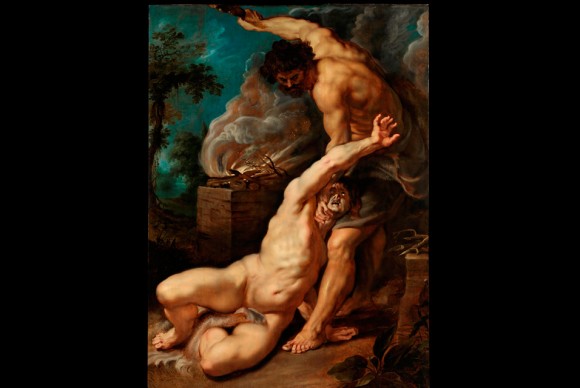Restored Rubens masterpiece goes back on public view at The Courtauld Gallery
February 2, 2012 by All Art News
Filed under Art Events & Exhibitions
LONDON.- The newly-conserved masterpiece Cain Slaying Abel by Sir Peter Paul Rubens went back on public display at The Courtauld Gallery, today. The magnificent painting, widely considered to be one of the most important in the Gallery’s world-class collection of works by Rubens, has been restored as part of the Bank of America Art Conservation Project which was launched in 2010.
The Flemish master Rubens (1577-1640) was one of the most exciting and explosive artistic talents of early modern Europe . His energetic compositions, such as Cain Slaying Abel, greatly influenced his contemporaries as well as future generations of artists. One of the first works of Rubens’s artistic maturity and representing a pivotal moment in his early career, Cain Slaying Abel was painted around 1609, shortly after he had returned to his home town of Antwerp following years spent living and working in Spain and Italy. The dynamic composition and powerful portrayal of the Old Testament scene demonstrate the artist’s remarkable virtuosity in the depiction of flesh and musculature although the violence of the subject is at odds with Rubens’s beautiful rendition of Abel’s body.
Cain Slaying Abel entered The Courtauld Gallery as part of Count Antoine Seilern’s Princes Gate Bequest in 1978. Its state of preservation, with warped panels, splitting joins, scratches, uneven surface with areas of paint loss and yellowed and opaque varnish, has been a long-standing concern. The oak panel showed problems at the joins between the planks, and earlier attempts to rejoin the panel had left a stepped profile and the join at the centre had started to fail resulting in the paint surface beginning to blister. At some point during the 19th century a lattice of wood, known as a cradle, was applied to the reverse of the panel. This was intended to prevent the planks from moving but had caused stress to the panel support and had also attracted woodworm.
The eleven-month procedure was undertaken by conservators Kate Stonor and Clare Richardson in the Department of Conservation and Technology of The Courtauld Institute of Art. The cradle was removed, a delicate operation in itself; the small woodworm holes were filled with cellulose fibres; parts of earlier restorations which had compromised the painting were carefully removed, as was the yellowed varnish which disfigured the subtly modelled cool tones of the landscape in the background. They also had to find precise matches for the pigments and glazes where restoration was needed in order to stabilise the painting for the next hundred years.
Cain Slaying Abel will be hung above an impressive fireplace in The Courtauld Gallery’s Rubens Room and the Baroque Room, across from Moses and the Brazen Serpent which Stonor and Richardson have already conserved. Dr Caroline Campbell, Schroder Foundation Curator of Paintings, said: “We are delighted to have received one of Bank of America’s inaugural conservation awards for Rubens’s early masterpiece, Cain Slaying Abel. Besides revealing the full beauty of the work, research undertaken during conservation treatment has given us important new information about Rubens’s artistic practice.”
During the conservation process, Stonor and Richardson made many exciting discoveries: dendrochronology has dated the painting to between 1600 and 1612; ultra-violet photographs and X-rays showed that Rubens amended the composition of Cain’s club-wielding arm and the positioning of one of his eyes; infra-red imaging revealed line drawings beneath the tree in the background which is unusual for Rubens and could be the work of a landscape specialist, indicating that Rubens may already have established a workshop at this early stage in his career.
Rena De Sisto, Global Arts and Culture Executive at Bank of America Merrill Lynch, said: “The Art Conservation Project is designed to preserve artistic treasures from around the world, to enable audiences to experience diverse cultural traditions, and allow future generations to enjoy and learn from these works. At the same time it sets out to spotlight the growing need for art conservation and the increasing cost to museums of keeping their treasures in top condition. The Courtauld has an extensive Rubens collection and it is so rewarding to see this magnificent artwork restored to its former glory and back on display, hanging alongside the artist’s other esteemed pieces. The fastidious work undertaken over the course of the last year will enable countless audiences to experience the full drama of Cain Slaying Abel.”
Dr Ernst Vegelin, Head of The Courtauld Gallery, said: “The conservation of Cain Slaying Abel has preserved an extremely important work by one of the world’s best-known artists, and the new research and discoveries that have arisen from the project will now form part of our numerous public and university teaching programmes”.
Related posts:
- Restored Renaissance Masterpiece on View in New Installation at Metropolitan Museum
- Bank of America Art Conservation Project To Restore Global Cultural Treasures in 2011
- The Courtauld Collects! 20 Years of Acquisitions Opens Today
- Gothic tapestries from Spain, recently restored, on view together for first time at the National Gallery of Art
- James Hughes-Hallet to succeed Nicholas Ferguson as Chairman of the Courtauld Institute of Art


I did’t know that.